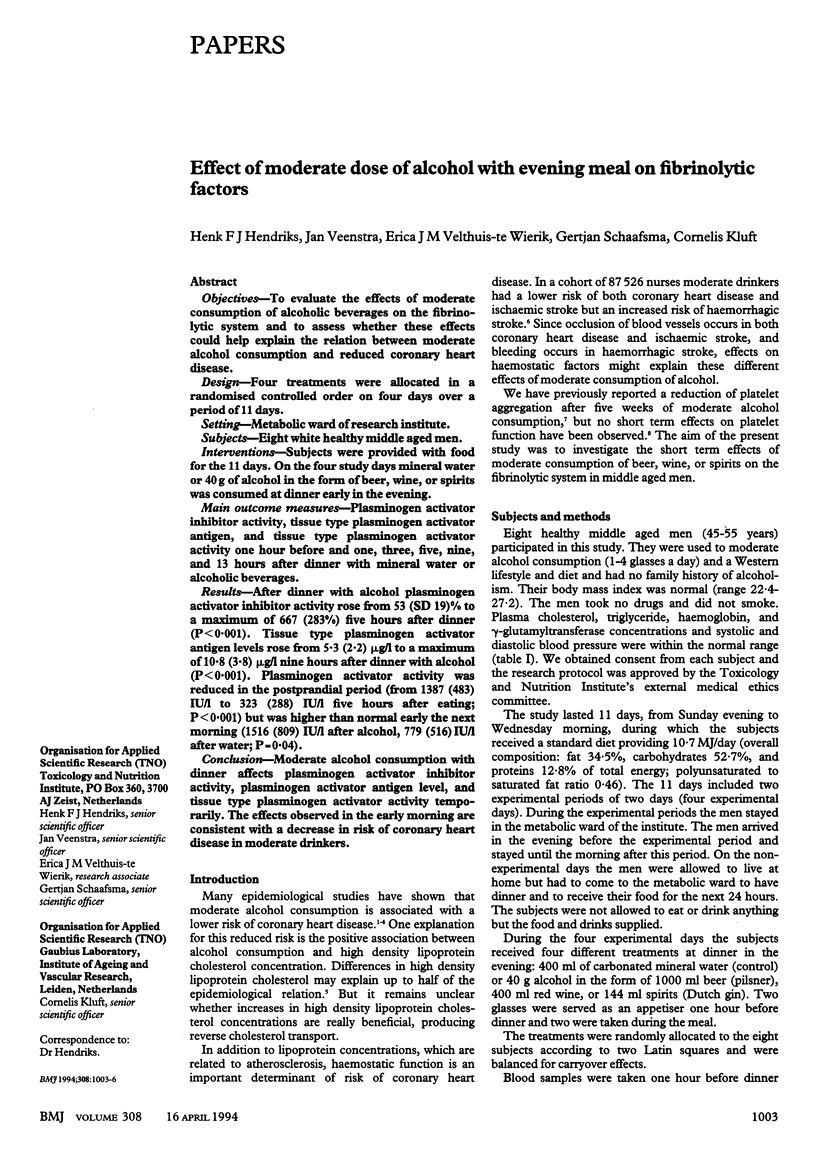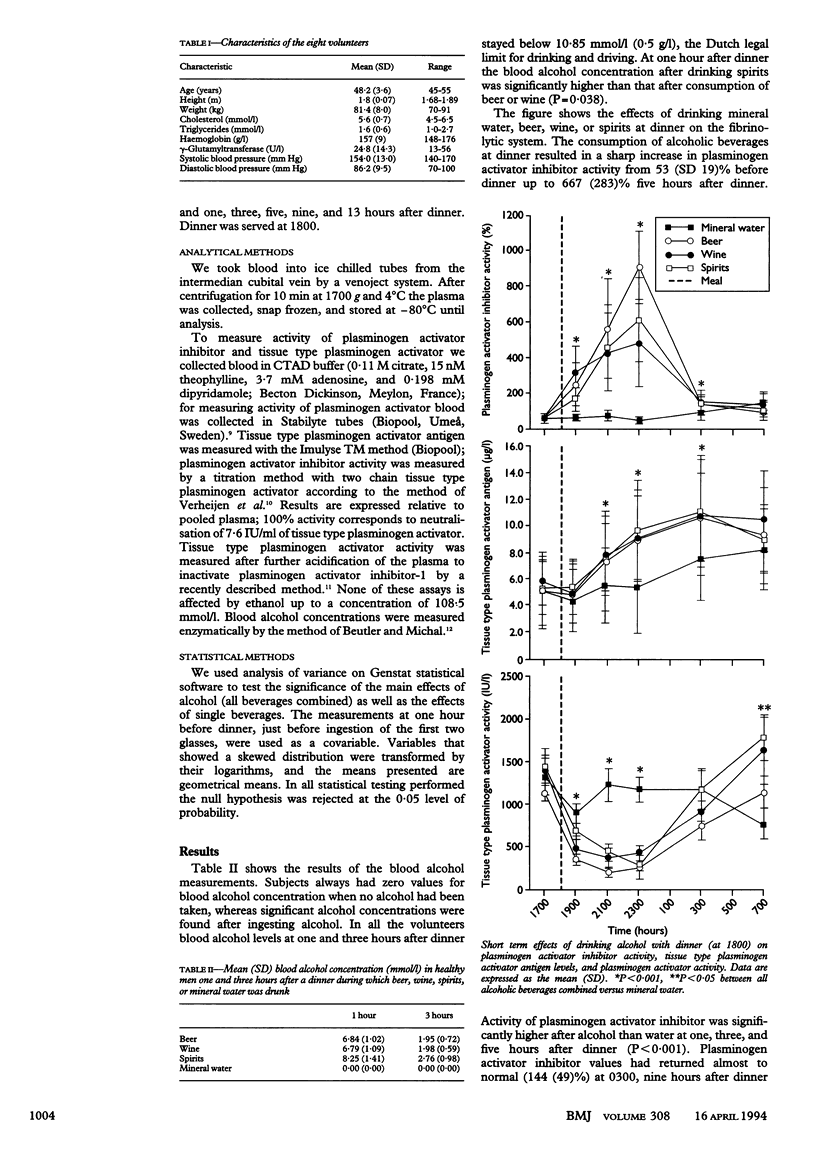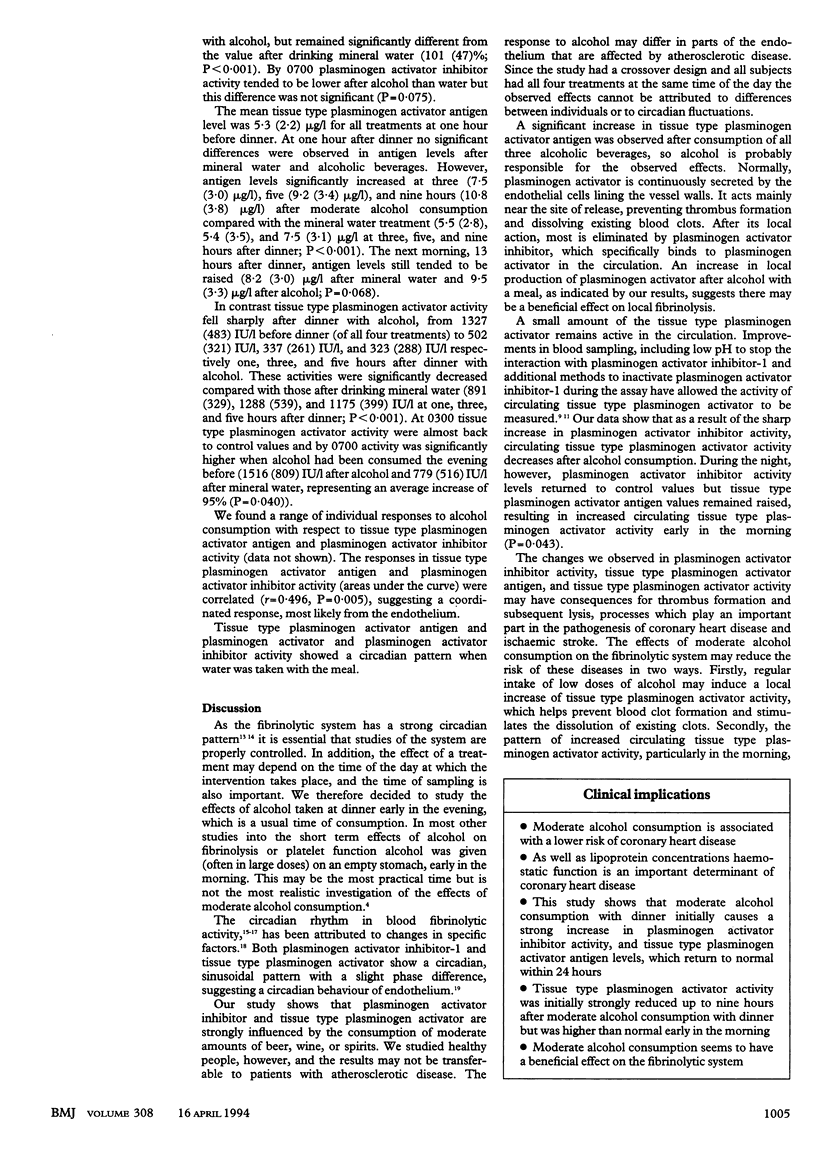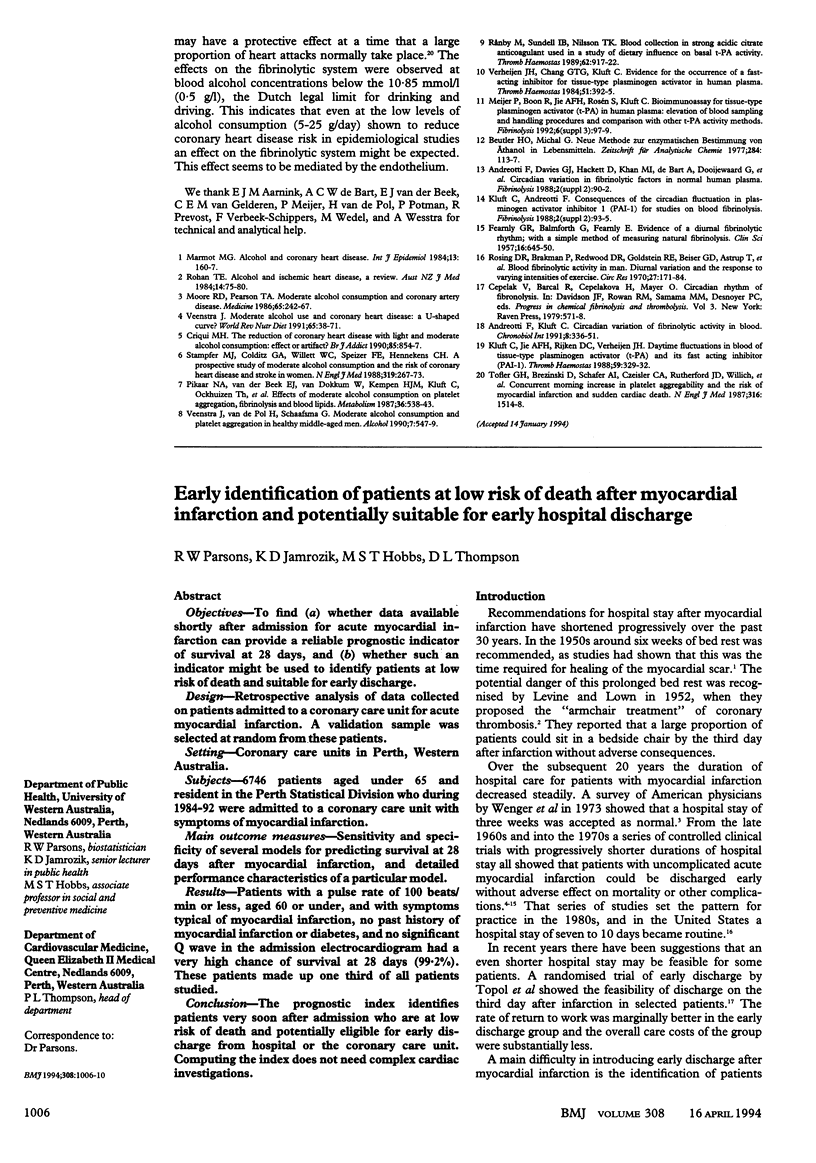Abstract
OBJECTIVES--To evaluate the effects of moderate consumption of alcoholic beverages on the fibrinolytic system and to assess whether these effects could help explain the relation between moderate alcohol consumption and reduced coronary heart disease. DESIGN--Four treatments were allocated in a randomised controlled order on four days over a period of 11 days. SETTING--Metabolic ward of research institute. SUBJECTS--Eight white healthy middle aged men. INTERVENTIONS--Subjects were provided with food for the 11 days. On the four study days mineral water or 40 g of alcohol in the form of beer, wine, or spirits was consumed at dinner early in the evening. MAIN OUTCOME MEASURES--Plasminogen activator inhibitor activity, tissue type plasminogen activator antigen, and tissue type plasminogen activator activity one hour before and one, three, five, nine, and 13 hours after dinner with mineral water or alcoholic beverages. RESULTS--After dinner with alcohol plasminogen activator inhibitor activity rose from 53 (SD 19)% to a maximum of 667 (283%) five hours after dinner (P < 0.001). Tissue type plasminogen activator antigen levels rose from 5.3 (2.2) micrograms/l to a maximum of 10.8 (3.8) micrograms/l nine hours after dinner with alcohol (P < 0.001). Plasminogen activator activity was reduced in the postprandial period (from 1387 (483) IU/l to 323 (288) IU/l five hours after eating; P < 0.001) but was higher than normal early the next morning (1516 (809) IU/l after alcohol, 779 (516) IU/l after water; P = 0.04). CONCLUSION--Moderate alcohol consumption with dinner affects plasminogen activator inhibitor activity, plasminogen activator antigen level, and tissue type plasminogen activator activity temporarily. The effects observed in the early morning are consistent with a decrease in risk of coronary heart disease in moderate drinkers.
Full text
PDF



Selected References
These references are in PubMed. This may not be the complete list of references from this article.
- Andreotti F., Kluft C. Circadian variation of fibrinolytic activity in blood. Chronobiol Int. 1991;8(5):336–351. doi: 10.3109/07420529109059170. [DOI] [PubMed] [Google Scholar]
- FEARNLEY G. R., BALMFORTH G., FEARNLEY E. Evidence of a diurnal fibrinolytic rhythm; with a simple method of measuring natural fibrinolysis. Clin Sci. 1957 Nov;16(4):645–650. [PubMed] [Google Scholar]
- Kluft C., Jie A. F., Rijken D. C., Verheijen J. H. Daytime fluctuations in blood of tissue-type plasminogen activator (t-PA) and its fast-acting inhibitor (PAI-1). Thromb Haemost. 1988 Apr 8;59(2):329–332. [PubMed] [Google Scholar]
- Moore R. D., Pearson T. A. Moderate alcohol consumption and coronary artery disease. A review. Medicine (Baltimore) 1986 Jul;65(4):242–267. doi: 10.1097/00005792-198607000-00004. [DOI] [PubMed] [Google Scholar]
- Pikaar N. A., Wedel M., van der Beek E. J., van Dokkum W., Kempen H. J., Kluft C., Ockhuizen T., Hermus R. J. Effects of moderate alcohol consumption on platelet aggregation, fibrinolysis, and blood lipids. Metabolism. 1987 Jun;36(6):538–543. doi: 10.1016/0026-0495(87)90163-6. [DOI] [PubMed] [Google Scholar]
- Rohan T. E. Alcohol and ischemic heart disease: a review. Aust N Z J Med. 1984 Feb;14(1):75–80. doi: 10.1111/j.1445-5994.1984.tb03596.x. [DOI] [PubMed] [Google Scholar]
- Rosing D. R., Brakman P., Redwood D. R., Goldstein R. E., Beiser G. D., Astrup T., Epstein S. E. Blood fibrinolytic activity in man. Diurnal variation and the response to varying intensities of exercise. Circ Res. 1970 Aug;27(2):171–184. doi: 10.1161/01.res.27.2.171. [DOI] [PubMed] [Google Scholar]
- Stampfer M. J., Colditz G. A., Willett W. C., Speizer F. E., Hennekens C. H. A prospective study of moderate alcohol consumption and the risk of coronary disease and stroke in women. N Engl J Med. 1988 Aug 4;319(5):267–273. doi: 10.1056/NEJM198808043190503. [DOI] [PubMed] [Google Scholar]
- Tofler G. H., Brezinski D., Schafer A. I., Czeisler C. A., Rutherford J. D., Willich S. N., Gleason R. E., Williams G. H., Muller J. E. Concurrent morning increase in platelet aggregability and the risk of myocardial infarction and sudden cardiac death. N Engl J Med. 1987 Jun 11;316(24):1514–1518. doi: 10.1056/NEJM198706113162405. [DOI] [PubMed] [Google Scholar]
- Veenstra J. Moderate alcohol use and coronary heart disease: a U-shaped curve? World Rev Nutr Diet. 1991;65:38–71. doi: 10.1159/000419467. [DOI] [PubMed] [Google Scholar]
- Veenstra J., van de Pol H., Schaafsma G. Moderate alcohol consumption and platelet aggregation in healthy middle-aged men. Alcohol. 1990 Nov-Dec;7(6):547–549. doi: 10.1016/0741-8329(90)90046-f. [DOI] [PubMed] [Google Scholar]
- Verheijen J. H., Chang G. T., Kluft C. Evidence for the occurrence of a fast-acting inhibitor for tissue-type plasminogen activator in human plasma. Thromb Haemost. 1984 Jul 29;51(3):392–395. [PubMed] [Google Scholar]


